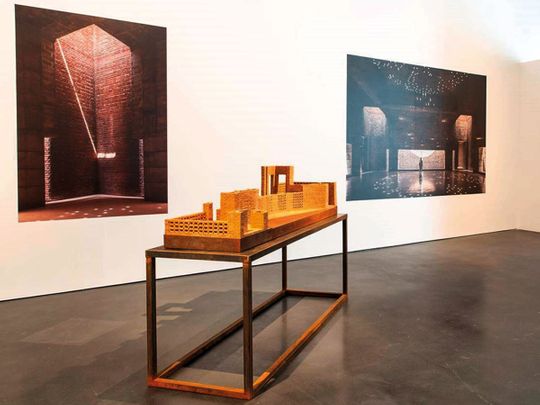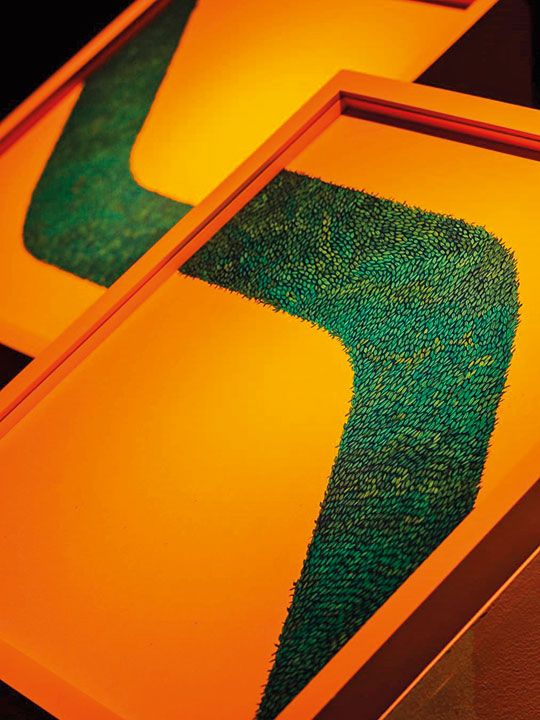
Dubai: The opening of the Jameel Arts Centre in Dubai, in 2018, paved way for the Victoria & Albert Museum’s (V&A) latest Jameel Prize exhibition to travel to the city for the first time.
The Centre is presenting Jameel Prize 5, featuring works by Mehdi Moutashar and Marina Tabassum, joint winners of the fifth edition of the prize as well as this year’s finalists, Kamrooz Aram, Naqsh collective, Hayv Kahraman, Hala Kaiksow, Younes Rahmoun, and Wardha Shabbir.
The variety of artworks in the show highlights the rich artistic heritage of the Islamic world, and its influence on contemporary creative practices. It also reflects the fact that this year’s Jameel Prize shortlist was the most diverse to date.
Fady Mohammed Jameel, president of Art Jameel says, “We have always worked in collaboration with like-minded organisations to create opportunities for artists from the Middle East and the wider Islamic world, and we take pride in our partnership with the V&A, which includes the Jameel Gallery of Islamic Art and the Jameel Prize. Over the past decade, the Jameel Prize has led to a broader understanding of Islamic culture and its artistically rich history, and the contemporary artists and designers it has inspired.”
The show is spread across several galleries. Occupying an entire gallery is Moroccan artist Rahmoun’s multimedia installation, Taqiya Nor (Hat-light), comprising 77 illuminated hats hand-knitted with recycled wool by a Moroccan artisan.
Each hat is different, representing the many forms of Islam, and they are arranged on the floor in ten rows signifying the ten main groupings within Islam.
The electrical wires linking them convey the message that despite their differences they are connected by the common faith.
l In the next gallery, French Iraqi artist Moutashar and New York-based Iranian artist, Aram’s works are displayed together highlighting their shared interest in investigating the relationship between Western modernism and Islamic aesthetic tradition of geometrical order and lines. Moutashar has used materials such as wood, metal plates and elastic wire stretched on nails to create abstract, geometric, folded forms, inspired by Arabic calligraphy and the mathematical ‘magic square’, which is one of the foundations of Arabesque patterns. Aram’s work examines how the West portrays Islamic art and how exhibition design and elaborate modernist settings shape viewers’ understanding of museum objects.
l Naqsh Collective’s intricate wood and brass ‘shawls’ are inspired by 18th and 19th century Jordanian, Syrian and Palestinian cross-stitch embroidery patterns. The Collective was founded by Jordanian sisters, architect Nisreen Abudail and graphic designer Nermeen Abudail. The Dubai-based duo have embarked on a project to document motifs, names, stories and areas where the embroidery comes from into digital format and then engrave the motifs onto wood, stone, brass and marble, preserving the spirit of the craft, while creating a new visual language.
l Bahraini fashion designer, Kaiskow also recontextualises her Arabian heritage by blending traditional crafts and weaves with international influences in her designs. For example, an ensemble from her Wandress collection includes a kimono-like vest with cartridge pleating drawn from a Cypriot shepherd’s water bag, paired with a cotton and latex jumpsuit derived from the traditional thobe worn by Bahraini women.
l Traditional Arabian dresses and patterns are also seen in Kahraman’s paintings on wood and linen, displayed in the same space. The Los Angeles based artist’s work reflects her experiences as an Iraqi refugee, and her paintings in this show recall her memories of the war in Iraq and her childhood home in Baghdad through fragile feminine figures based on 3D scans of her own body.
l Pakistani painter, Shabbir’s intricate paintings of clusters of tiny leaves, flowers and birds reflect her training in traditional miniature painting. The meditative works invite viewers to contemplate the minute details of life and our relationship with each other and with nature.
l Bangladeshi architect Tabassum’s prize-winning work, the Bait ur Rauf Mosque, in Dhaka, is on a much larger scale but equally subtle and spiritual. She is the first architect to win the Jameel Prize, and she also won the Aga Khan Award for Architecture for this design. A hand-made model, floor plans and videos of the simple mud-brick structure, filled with natural light articulate her new language of architecture that is global, but is rooted in local culture, history and aesthetics.
The exhibition also includes videos of the artists talking about their practice and process, and information about previous Jameel prize finalists. As part of the accompanying free public programme, Naqsh Collective will discuss their research with writer, curator Rachel Dedman on September 7, in a conversation titled, The Language of Palestinian Embroidery; and Nora Razian, Art Jameel’s head of exhibitions will lead a curatorial tour of the show at 4pm on September 14.
WHAT IS JAMEEL PRIZE?

The Jameel Prize is the only global award that recognises contemporary artists and designers whose practice is inspired by Islamic design and visual culture. Founded in 2009, the biannual prize is a collaboration between the Victoria & Albert Museum in London (V&A) and Art Jameel, building on their partnership in the V&A’s Jameel Gallery of Islamic Art. Works by the winners and finalists of every edition of the prize are presented to the public in an exhibition hosted by the V&A, which also tours around the world, thus contributing to a broader understanding of Islamic culture and its place in the contemporary world.
Jameel Prize 5 will run at The Jameel Arts Centre, Jaddaf Waterfront, Dubai until September 14.
— Jyoti Kalsi is a Dubai-based arts enthusiast











